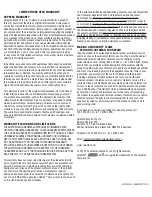
TO OPERATE HEADLAMP
1. Three lighting modes are available: Red,
Low & High.
2. Operate by pressing the power button on
top of the headlamp. Each cycle of the
power button will advance the headlamp
to the next mode. Operating in the Low
mode will extend the battery life.
3. This headlamp is designed with a
convenient feature that allows the
headlamp to be powered off with one click after the headlamp has been
operating in one mode for more than 10 seconds.
THINGS YOU SHOULD KNOW
1. Operating time for this light depends on whether it is run continuously
or intermittently. Intermittent operation extends the run time of the
batteries.
2. LEDs are lifetime light sources and do not need to be replaced.
IMPORTANT SAFETY
INSTRUCTIONS
WARNING: When using electric
appliances, basic precautions should
always be followed, including the
following:
1. Keep AAA batteries away from
small children. If swallowed
promptly see a doctor and have
the doctor phone (202) 625-3333
collect.
2. Do not install the batteries
backwards, follow the + and
- symbols as shown in the
instructions. Do not charge or
put in a fire. Do not mix alkaline,
standard, or rechargeable
batteries. Do not mix old and
new batteries. The batteries may
explode or leak causing injury.
3. Do not leave discharged batteries
in the product for an extended
period of time as this could
permanently damage the product.
4. Replace all batteries at the
same time.
SAVE THESE INSTRUCTIONS
INSTRUCTION SHEET
CHT4 2AAA HEADLAMP
TO INSTALL OR REPLACE BATTERIES
IN HEADLAMP
Your new headlamp operates on two “AAA”
cell batteries. For longest life, use alkaline
batteries.
1. Aim the headlamp to the lowest position.
(Fig. 1)
2. Open the battery door by using key
provided on the adjustor of the headlamp
strap. Gently pry the door slot to open.
(Fig. 2)
3. Install the batteries with the correct
polarity as marked on the headlamp.
(Fig. 3)
4. Close the door by pressing firmly on the
door until it snaps to the closed position.
(Fig. 4)
Fig. 1
Fig. 2
Fig. 3
Fig. 4







